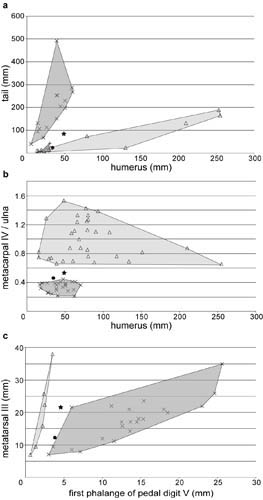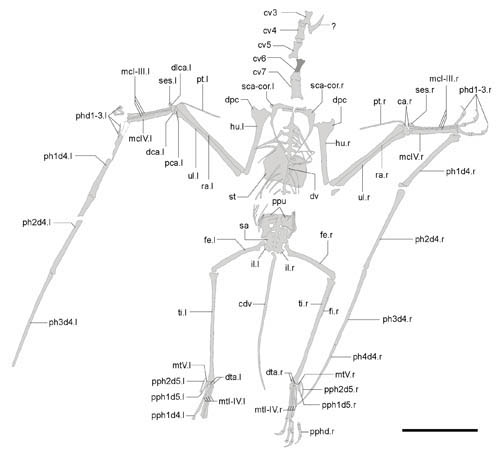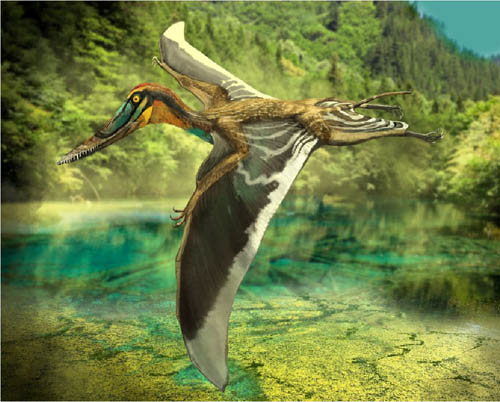On February 16, 2017, Scientific Reports published an article by Wang Xiaolin’s research team at the Institute of Vertebrate Paleontology and Paleoanthropology, Chinese Academy of Sciences, Jiang Shunxing and Cheng Xin, and Linyi University’s Institute of Geology and Paleontology, Wang Xiaoli, Zhang Junqiang, and others. The latest results of the study on the origin of Chirosaurus. The pterosaur fossil reported in this study belongs to the Jurassic Yanliao Biota, and the specimen was produced from Linglong Tower in Jianchang, Liaoning. The specimen's tail vertebrae, wing metacarpals and fifth toe are all between those of pterodactyls and non-pterodactyls. Based on these characteristics, it was named Douzhanopterus zhengi. The discovery of this specimen provides insight into the evolution of the postcranial skeleton in the origin of pterodactyls.
In the traditional classification system, pterosaurs can be divided into long-tailed "rhynchosaurs" (non-pterodactyls) and short-tailed pterodactyls (pterodactyls). The former is more primitive and the latter Relatively progressive. Since the application of phylogeny in the study of pterosaurs, the results of cladistic analysis have shown that only pterodactyls are a monophyletic group, while the "Rhinorhynchids" are a group that includes all the basal groups of pterosaurs. It is a polyphyletic group within the group, so it is also called non-pterodactyl. Pterodactylids all have a healed antorbital fenestra, significantly lengthened wing metacarpals, a shortened tail, and a vestigial fifth toe. These characteristics are clearly different from non-pterodactyls, and any one of these characteristics has long been used. to differentiate between pterodactyls and non-pterodactyls.
Since 2009, the Chinese and Brazilian pterosaur research teams led by Wang Xiaolin first studied and named Wukong pterosaurs, established the family Wukong pterosaurs, and successively reported multiple types of Wukong pterosaurs. Without exception, the head bones of these pterosaurs are similar to those of pterodactyls, with healed nasoorbital foramen; the cervical vertebrae and wing metacarpal bones are relatively elongated, and the degree of elongation is greater than that of non-pterodactyls but smaller than that of pterodactyls; their elongated The tail and specially developed fifth toe are very similar to non-pterodactyls. Wukong Pterosaur, Darwin Pterosaur and Kunpeng Pterosaur are the more confirmed members of Wukong Pterosauridae at present. These members are all considered to be the transitional link in the evolution of non-pterodactyls to pterodactyls.
Recently, two unnamed pterosaur specimens were also discovered in the Late Jurassic Solnhofen Limestone in Germany, which is famous for producing Archaeopteryx. Their skull morphology is not significantly different from that of pterodactyls from the same place. , the bones behind the head are also relatively similar, but the number and length of its tail vertebrae are slightly larger than those of pterodactyls, but significantly smaller than those of non-pterodactyls. The fifth toe has two digits similar to those of non-pterodactyls, but each digit is very vestigial. Therefore, this unnamed type is considered to be the last step in the evolution of non-pterodactyls into pterodactyls.
Through morphological and systematic studies on the fossils of Zheng's Douzhan Pterosaur, researchers believe that Douzhan Pterosaur is better than Wukong Pterosaur in key features of pterosaur evolution such as cervical vertebrae, tail, wing metacarpal bones and feet. The class is more advanced, and phylogenetic analysis also supports this view. Compared with the unnamed specimen found in Germany, the tail of Douzhan Pterosaurus is more primitive, and the system position is also more primitive than the unnamed type in Germany. The discovery and research of Douzhan pterosaurs has led to the evolution of pterosaurs from "rhynchophons" - Wukong pterosaurs - Douzhan pterosaurs - German unnamed types - pterodactyls, a chain of origin and evolution of pterodactyls. More complete and clear.
In the scatter plot of the changes in the three main characteristics of non-pterodactyls and pterodactyls, the distribution areas of the two can be clearly distinguished. Among them, in terms of the relationship between the length of the tail and the size of the body (humerus), non-pterodactyls, except for the more special frog-mouthed pterosaurs, all have long tails, while all pterodactyls have short tails, which is just right for Douzhan pterosaurs. Located in the area between the two; in terms of the distribution of the ratio of the wing metacarpal bones to the ulna relative to the size of the pterosaurs, it is clearly divided into larger pterodactyls and smaller non-pterodactyls. Fighting pterosaurs once again Appears between these two areas; the relationship between the first phalanx of the fifth toe and the sole of the foot also shows obvious differences between the two. The position of Dou Zhan Pterosaur is also between the two.
Zheng's Douzhan pterosaur occurs in the Daohugou Formation (or Tiaojishan Formation) of the Yanliao Biota in the Late Jurassic. Compared with the large number of Wukong pterosaurs in the same formation, only Douzhan pterosaur has been found so far. specimen. Based on this, it is speculated that Douzhan Pterosaur may have just appeared in the earliest period of the Late Jurassic (about 160-161 Ma). At this time, Wukong Pterosaurs occupied the dominant position, and Douzhan Pterosaur may have appeared for the first time slightly earlier. During this period, Wukong pterosaurs may have appeared earlier.
The genus name of Dou Zhan Pterosaur and Wukong Pterosaur come from the famous Chinese mythological novel "Journey to the West". Sun Wukong can soar into the clouds and ride in the mist and undergo seventy-two transformations, and he can do whatever he wants between heaven and earth. Wukong Pterosaur is also located in the key transitional link of "change" between "rhythhynchids" and pterodactyls. It has the common mosaic characteristics of both, so it is named accordingly. The fighting pterosaur is a type of pterosaur that further evolved from Wukong's pterosaurs. In the end, Sun Wukong was named the fighting and defeating Buddha for protecting Tang Sanzang's success in obtaining Buddhist scriptures from the West. The species name of Zheng's fighting pterosaur was given to Director Zheng Xiaoting, the founder of Tianyu Natural History Museum in Shandong Province, to thank him for his strong support of this collaborative research.
This research was supported by the National Natural Science Foundation of China, the 973 Project of the Ministry of Science and Technology, and the Strategic Priority Science and Technology Project (B) of the Chinese Academy of Sciences.

Figure 1 Douzhanopterus zhengi. Scale bar a: 5 cm; b, c: 1 cm (Photo provided by Jiang Shunxing)

Figure 2 Line drawing of Zheng fighting a pterosaur. Scale bar: 5 cm (photo courtesy Jiang Shunxing)

Figure 3 Scatter plot comparing the characteristics of Zheng’s Douzhan pterosaurs. êZheng's fight with the pterosaur? German unnamed type, r pterodactyl,? Non-pterodactyls (photo courtesy Jiang Shunxing)

Figure 4 Ecological restoration map of Zheng’s fighting pterosaurs (drawn by Zhao Chuang)
animal tags: pterosaur pterosaurs specimen fossil dinosaur Archaeopteryx
We created this article in conjunction with AI technology, then made sure it was fact-checked and edited by a Animals Top editor.